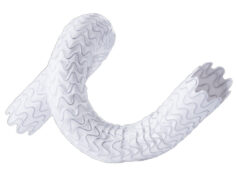
At the recent Cardiovascular and Interventional Radiological Society of Europe (CIRSE) annual meeting (14–18 September, Lisbon, Portugal), Kate Steiner (East and North Herts NHS Trust, Stevenage, UK) presented the results of a recent study comparing intimal hyperplasia measurements on ultrasound of pre- and post-percutaneous transluminal angioplasty (PTA) of arteriovenous (AV) access stenoses with both paclitaxel-coated balloons and plain balloon angioplasty.
After outlining the benefits of drug-coated balloons (DCBs) for use in PTA, as well as some of the “mixed” trial results, Steiner shared the aims and methods of the trial with the CIRSE audience. The two aims of the trial were, as she stated, to examine intimal hyperplasia measured on B-mode ultrasound pre- and post-PTA procedures quantified as % intimal–media thickness (IMT), and to determine whether there is a significant decrease in intimal hyperplasia post angioplasty comparing DCB angioplasty with plain balloon angioplasty.
To meet these aims, Steiner and colleagues performed a pre-procedural duplex ultrasound for the investigation of dialysis fistula dysfunction—“as is standard practice at our institution,” Steiner stated. Once the procedure was complete, patients were then followed up with a duplex ultrasound and clinical review six to 12 weeks post-intervention. A total of 191 consecutive PTA procedures for AV access dysfunction were screened retrospectively for inclusion, with those procedures where there was an ultrasound prior to and following PTA, with measurements of IMT, included. The two DCBs that were used were Lutonix (BD) and Ranger (Boston Scientific).
Eighty-seven patients were included in the study, with a total of 99 stenotic lesions. Twenty-six of the 99 lesions were treated using DCB angioplasty, and 83 were treated using plain balloon angioplasty. All duplex examinations were within 180 days pre- and post-procedure. The average pre-PTA duplex in days was 45, with the average post-PTA duplex being 65. What the researchers found was that there was a greater difference in %IMT post-PTA in the DCB group, with a minimal decrease in IMT in the plain balloon group.
Steiner then concluded her presentation, stating that she and the other researchers saw a significant decrease in %IMT post-PTA using a DCB, when compared to the plain balloon angioplasty group. This, she argued, demonstrates an antiproliferative drug effect on lesion intimal hyperplasia. She also highlighted, however, that this did not translate into a sustained difference in target lesion primary patency, despite the more positive outcomes with use of DCBs. Drawing her presentation to a close, she said that further investigation examining lesion response to antiproliferative therapy is warranted.
Sharing her thoughts on the results from this study with Renal Interventions, Steiner said: “As well as using patency rates as outcomes measures in clinical studies, we can also examine lesion morphology as a response to antiproliferative therapy. The %IMT measurements we have made are easily reproducible.” Adding some context to the results, she added: “I think in our study, we did not see a decrease in %IMT translate into improved patency rates because we primarily used the DCBs in a higher risk group. Lesions had a higher baseline %IMT and had had a higher number of previous angioplasties.”
She also added that selected centres in the PAVE 2 clinical study, which has recently started recruiting in the UK, will be examining lesion morphology using b-mode ultrasound pre and post PTA procedures. “The study is a 3 armed prospective RCT,” she stated, “comparing plain balloon angioplasty with paclitaxel coated balloon angioplasty and sirolimus coated balloon angioplasty.












